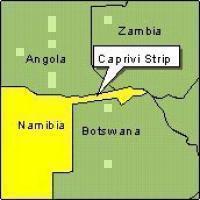







|
News and Information
Attack on Mpacha brings high treason trial back to a battle over photographs
| August 1, 2006 |
 Attack on Mpacha brings high treason trial back to a battle over photographs Attack on Mpacha brings high treason trial back to a battle over photographs
WERNER MENGES
THE main Caprivi high treason trial resumes in the High Court today with a long-simmering dispute over the use of photo albums of the 119 men who are accused in the trial set to be brought to a head.
The prosecution and defence teams are set to square off when they argue on an issue that has dominated the trial since mid-May.
That issue is about the use of an album with photographs of the 119 accused, and specifically whether Judge Elton Hoff should admit the album as evidence in the trial or not.
The prosecution team intends using the album as a tool through which its witnesses can try to identify accused persons that they have mentioned in their testimony before court.
Attempts to let State witnesses look through the ranks of the large group of men on trial before Judge Hoff have increasingly turned into an exercise of diminishing returns, with successive State witnesses telling the court that they were unable to recognise anyone in the ranks of the 119 accused men.
An attempt by Deputy Prosecutor General Taswald July to let the prosecution's latest witness in the trial, Walters Nkwezi Sikoshi, have a look at a photo album provoked the latest objection by a defence lawyer against the use of such material.
This set the stage for today's arguments.
Sikoshi, the 60th prosecution witness to testify in the trial, is the first witness to testify that he actually took part in one of the armed attacks that an alleged separatist organisation, the Caprivi Liberation Army, is claimed to have carried out at Katima Mulilo on August 2 1999.
According to Sikoshi, who said he is now employed by the Namibian Police, the attack that he was part of was more of an unarmed onslaught than an armed one.
He told the court that he joined an exodus of people from the Caprivi Region to Botswana in November 1998, after friends had promised him that they would be able to further their studies in Botswana.
When these promises of education proved to be empty, he returned to Namibia in June 1999, he told the court.
It was during the night of July 31 1999 that he heard a knock at his door and received an instruction to get dressed and accompany a group of five men who were outside, he said.
He was taken to a place in the Makanga area - this is alleged to have been a gathering and training ground for the people accused of staging the August 2 attacks - where he spent the next day, he said.
Sikoshi said there were about 100 other people there.
He listed the names of 39 people - plus an unnamed witchdoctor - that he said he saw at the same place the next day.
Most of them were unarmed, and they spent that day - the day before the attacks took place - lazing around, sitting and doing nothing much all day long, according to his testimony.
On the afternoon of August 1 1999, one of the people at the camp, Shadrick Chainda, addressed them all, Sikoshi said.
"(W)e were told that 'today is the last day and what will happen is we will fight against the force members of the Namibian Police, Namibia Defence Force'.
If possible we had to conquer and once we will conquer a flare will be shot in the sky to notify each and everyone that everything has been done," Sikoshi related.
He said the people moved out at around midnight, after receiving a round of treatment from the witchdoctor.
Sikoshi claimed he was in a group of about 15 people, led by Bennet Mutuso - the name of one of the men on trial - who were supposed to attack the Mpacha military base near Katima Mulilo.
Most of the 15 were unarmed, though.
Their brief was to attack the base, get access to a weapons storeroom, get weapons from there, and then continue their attacks, Sikoshi said.
The attack did not go according to plan, however.
"What was supposed to happen, was to win, but we did not win," Sikoshi summarised the predicament that the Mpacha attackers quickly found themselves in.
Out of his group of 15 supposed attackers at Mpacha, only Mutuso and his second-in-command, named as one Hansmeyer Tungula, were armed, according to Sikoshi.
Tungula was wounded after firing only two shots, Sikoshi told the Judge.
He said he and other members of the group went to ground after Tungula had been wounded, escaping from the army base at around 05h00.
Had he had his own firearm that night, he would have used it, Sikoshi told the court.
Now, however, he claimed, he has changed his mind about the idea of attacking Namibia's armed forces.
"I changed the view simply because the Government is stronger than anyone," he said.
The trial is set to continue today, and possibly tomorrow, before it will again be adjourned for a recess until mid-September.
|
Source: www.namibian.com.na |
| http://www.namibian.com.na/ |
|
| Support Caprivi Freedom |
Fill out the form below to become a member of this site and receive our regular newsletter.
|

|

